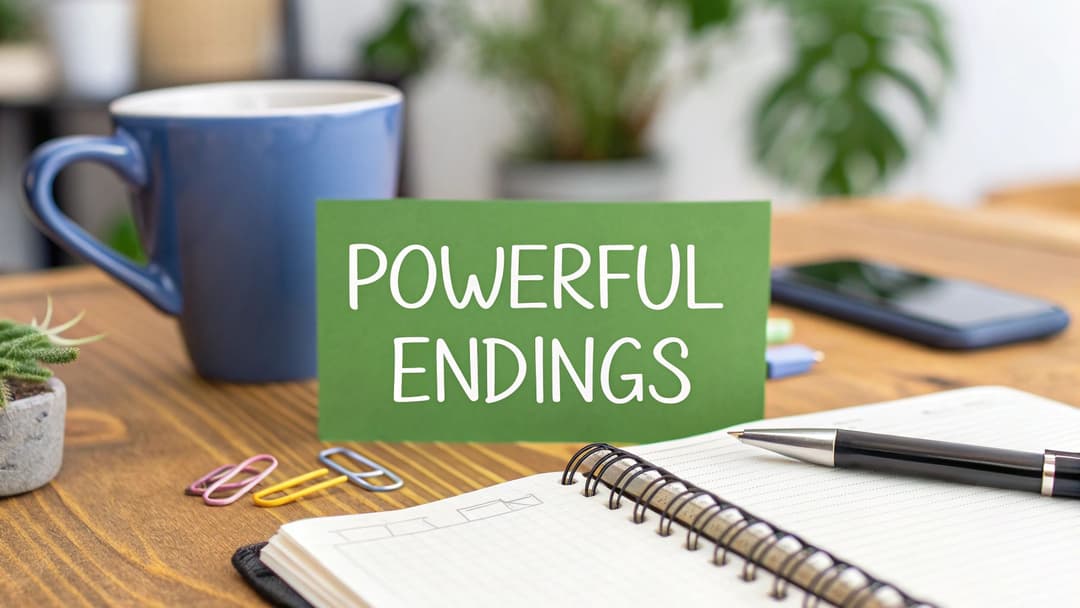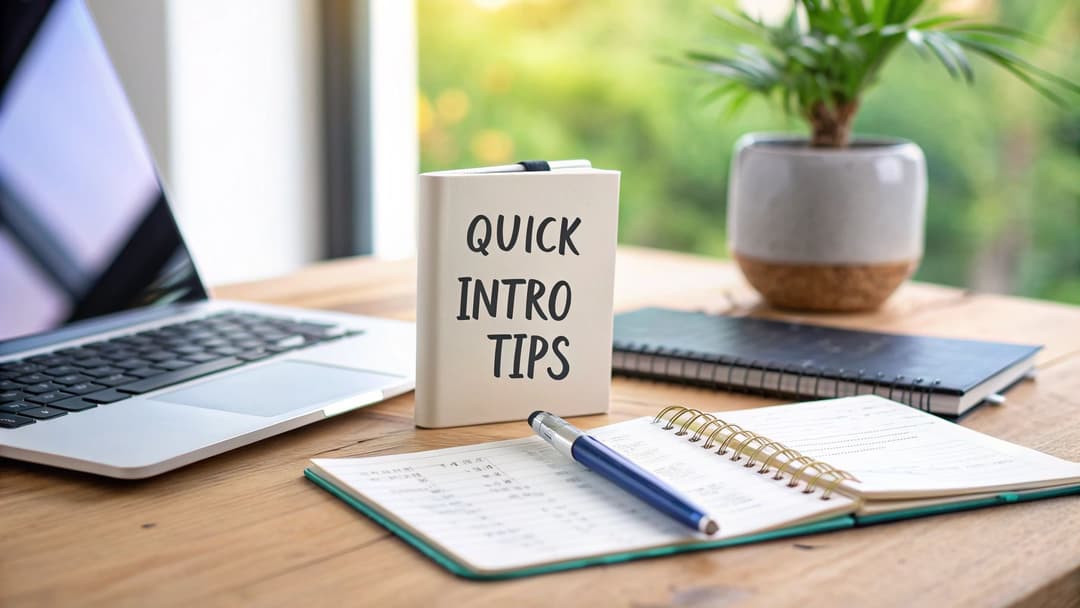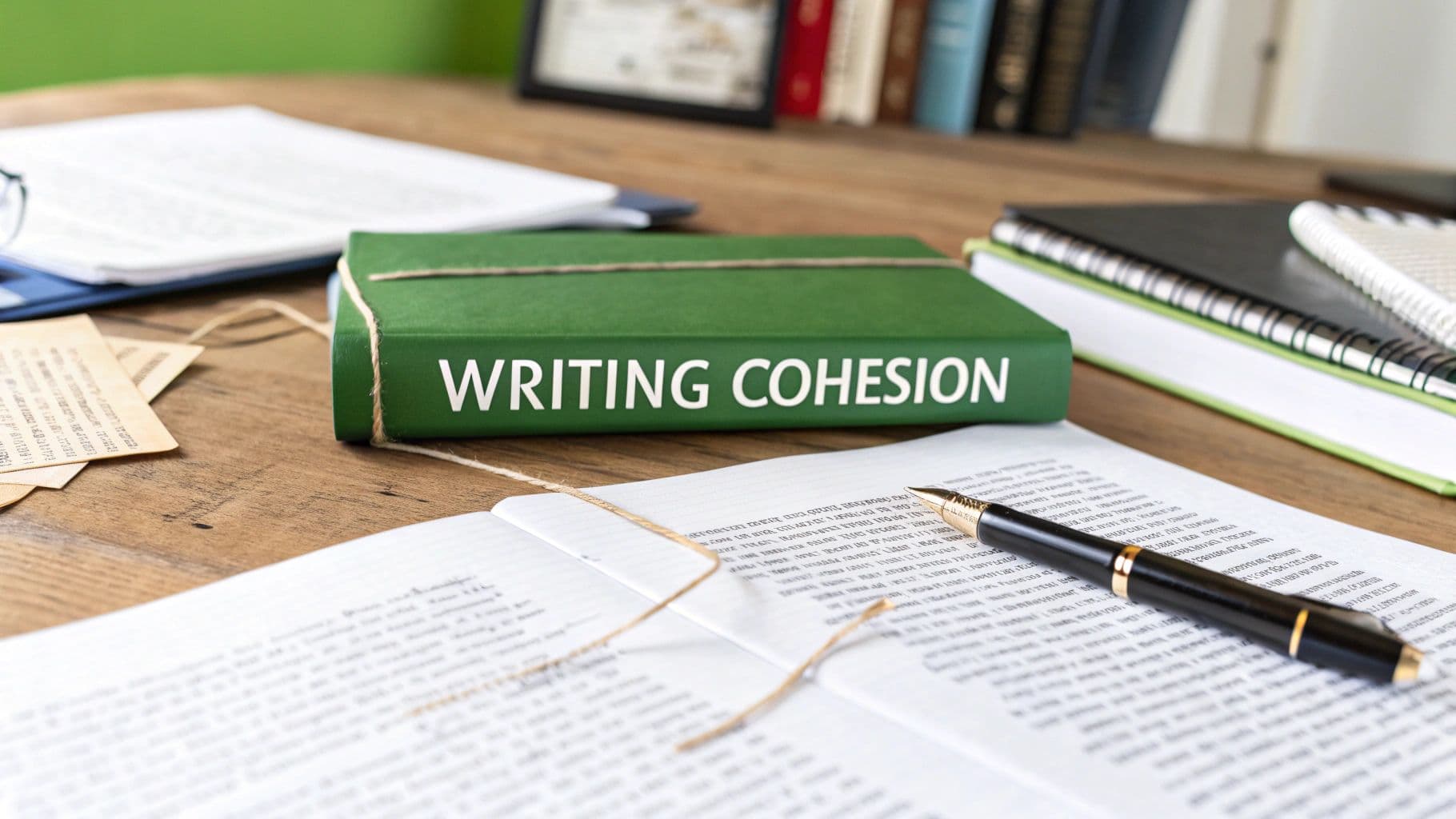
What Is Cohesion in Writing and How to Master It
November 24, 2025
At its core, cohesion in writing is all about connection. It's the technical side of making sure your sentences and paragraphs are glued together in a way that makes sense, creating a smooth and logical path for your reader.
It's how you use specific words and phrases to guide your audience from one idea to the next without any bumps in the road.
Understanding Cohesion in Writing
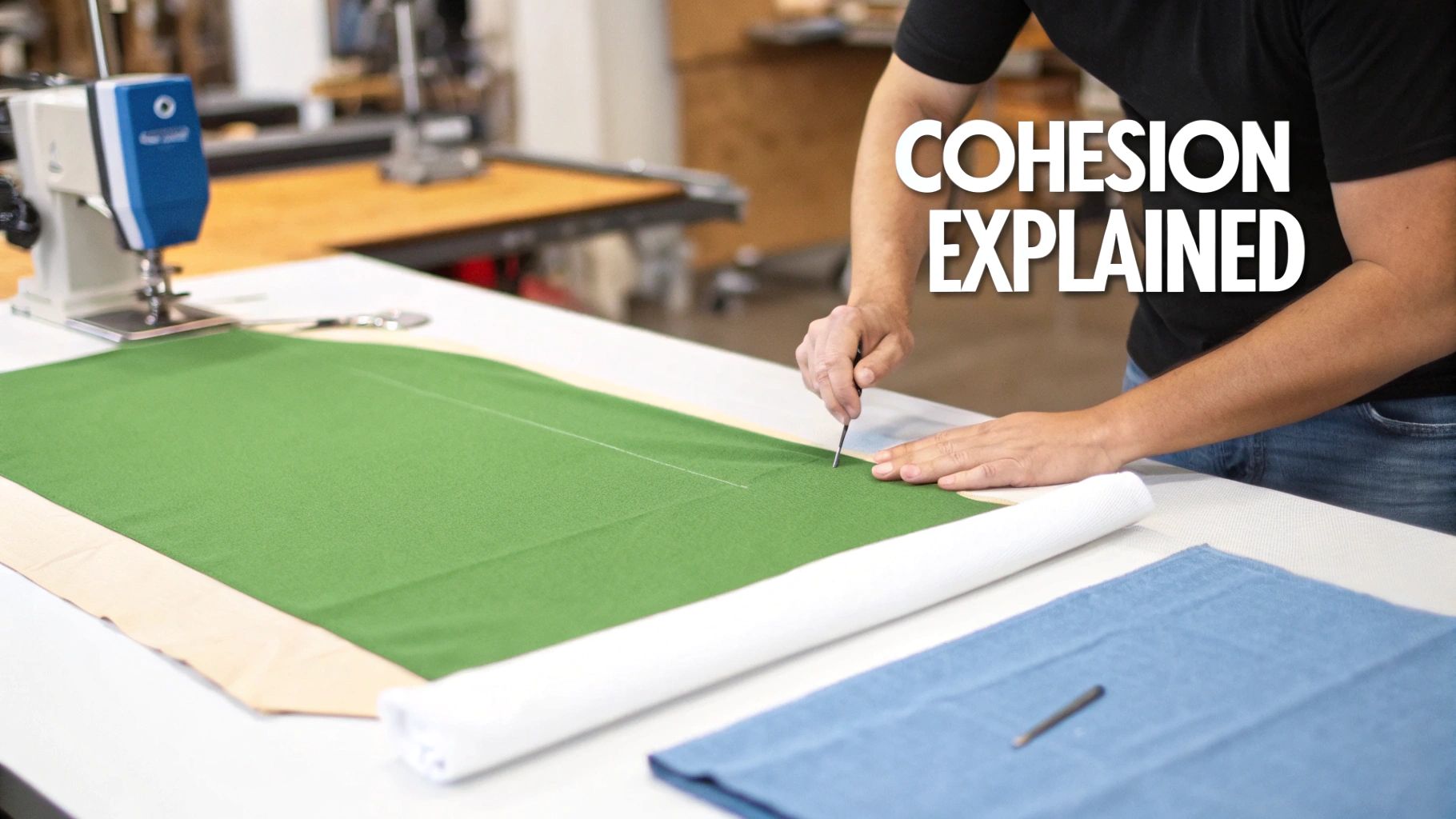
A good way to think about cohesion is like the stitches holding a piece of clothing together. Without those threads, all you have are random scraps of fabric. In writing, your sentences are those scraps. Cohesion provides the threads that turn a pile of disjointed thoughts into a strong, seamless whole.
This isn't just about sounding smart; it's about being clear. When a text lacks cohesion, you’re forcing your readers to do the hard work of piecing your meaning together. They’ll get tripped up by clunky transitions, confused by vague pronouns, and might even lose track of your main point altogether.
Effective cohesion is the hallmark of a considerate writer. It anticipates the reader's journey, building bridges from one idea to the next so they never get lost.
Why Is Cohesion Important
Getting a handle on cohesion has a direct impact on how well your message lands. It's what separates a random collection of sentences from a single, powerful piece of communication. Good cohesion makes your writing feel polished, intentional, and, most importantly, easy to follow.
Linguists talk about specific tools for this—like referencing, substitution, and conjunctions—that create these crucial links. You can dive deeper into these foundational concepts of cohesion in English to see how they work on a grammatical level.
Good cohesion helps you connect with your readers and deliver your message more effectively. Mastering it brings a handful of key benefits that elevate both your writing and the reader's experience.
Key Benefits of Cohesive Writing
| Benefit | Impact on Your Writing | Reader Experience |
|---|---|---|
| Improves Readability | Your ideas flow logically, making the text feel effortless and intuitive. | Readers can follow your train of thought without having to stop and re-read. |
| Strengthens Your Argument | Each point builds clearly on the last, creating a more persuasive and solid case. | The argument feels logical and convincing, making it easier for them to trust your point. |
| Enhances Professionalism | Polished writing signals clarity of thought and respect for the reader's time. | The content feels authoritative and credible, which builds trust with your audience. |
| Boosts Engagement | A smooth, natural flow keeps readers locked in and focused on your message. | The reading experience is enjoyable, not a chore, so they're more likely to finish. |
In the end, focusing on these techniques ensures your hard work pays off by making your writing not just readable, but genuinely compelling.
Unpacking Cohesion vs. Coherence
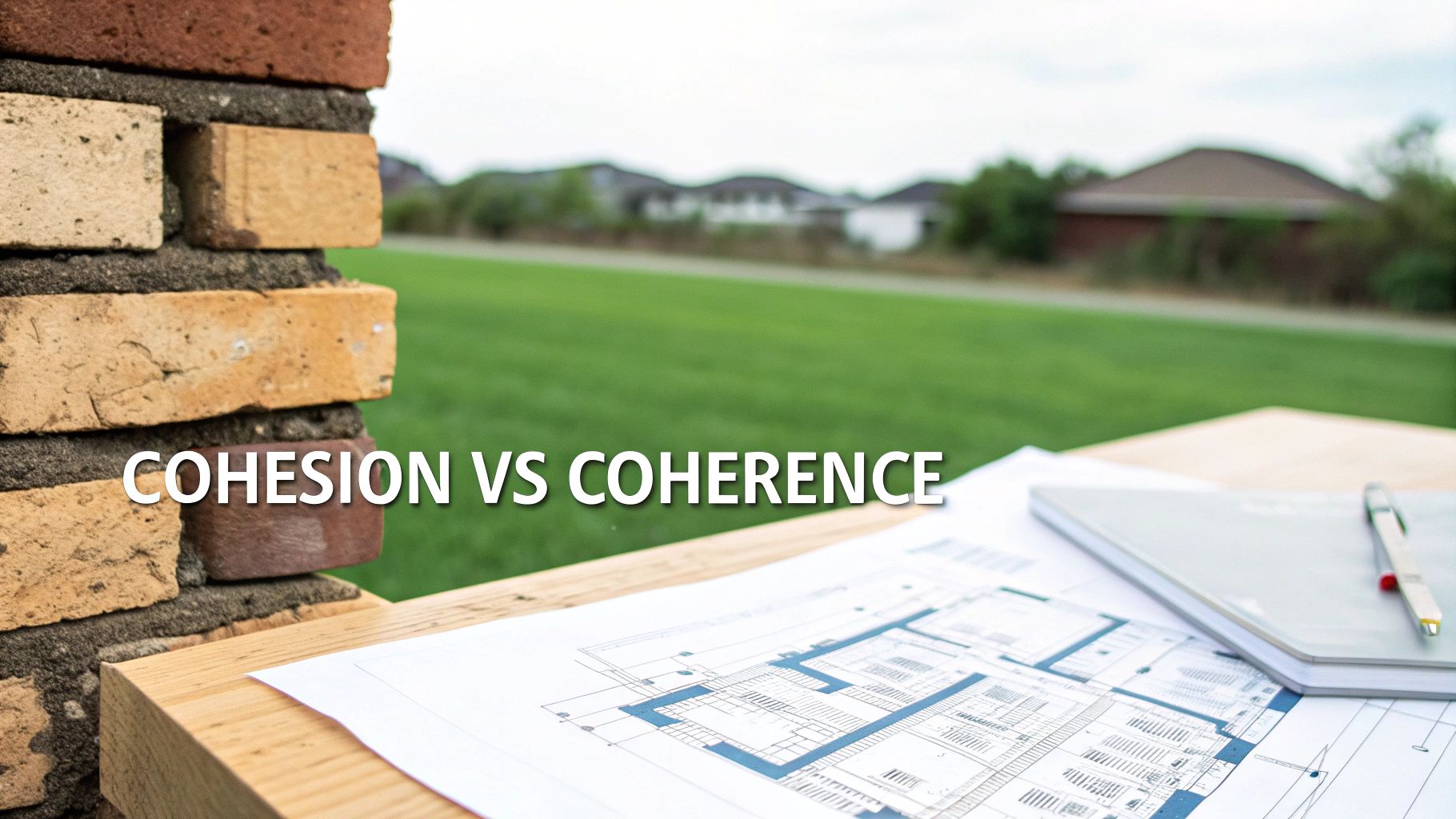
Writers often toss around the words cohesion and coherence like they’re the same thing. They’re not. And figuring out the difference is the first step to diagnosing why your writing might feel "off" to a reader.
Think of it like building a house.
Cohesion is the bricks and mortar. It’s the small-scale, sentence-to-sentence glue that holds your writing together. This is where things like pronouns, transition words, and synonyms come in, creating a smooth, connected flow. It’s all about the technical links.
Coherence, on the other hand, is the architectural blueprint. It’s the big-picture logic of the entire piece. A coherent article has a clear point, makes sense from the first sentence to the last, and all the paragraphs work together to build a single, solid argument.
Why The Distinction Matters
Here’s the thing: you can have one without the other, and that’s where the problems start.
You can nail cohesion but completely fail at coherence. Your writing could be grammatically perfect, with every sentence flowing beautifully into the next, but the whole thing might add up to absolutely nothing. It’s like a perfectly built brick wall standing alone in an empty field—the craftsmanship is impressive, but it’s totally pointless.
For example, look at this paragraph:
My favorite color is blue. Blue is the color of the sky, which planes fly through. Airplanes are fascinating machines, and my uncle was a pilot. He used to live in Arizona.
See how each sentence connects to the previous one? The links are there (cohesion), but the paragraph wanders aimlessly. There’s no central idea, no reason for it to exist (no coherence).
On the flip side, you could have a brilliant, coherent idea but execute it with clunky, disjointed sentences. That’s like having a great blueprint but building the house with crumbling bricks and weak mortar. The grand design is there, but the structure is too wobbly for anyone to live in.
Knowing the difference helps you fix the right problem. If your readers get lost moving from one sentence to the next, you’ve got a cohesion issue. If they understand each sentence just fine but can’t figure out your overall point, you’ve got a coherence problem.
Mastering both is what separates good writing from great writing—the kind that’s not just easy to follow, but truly persuasive.
Mastering the 5 Types of Cohesive Devices

If you really want to get a grip on what cohesion in writing is, you need to know the tools that build it. Cohesive devices are the words and phrases that act like glue, holding your sentences and paragraphs together. Think of them as the nuts and bolts a writer uses to build a bridge from one idea to the next.
There are five main types, and each one does a different job. Once you learn how to use them, you can guide your reader without them ever feeling lost or confused. Your writing will just feel right.
Let's break them down.
1. Reference Words
Reference words are basically pointers. They refer back to a person, place, or idea you’ve already mentioned, which saves you from sounding clunky and repetitive. The most common ones are pronouns like he, she, it, they, this, and that.
Instead of saying the same noun over and over, you just swap in a pronoun to keep things moving.
- Before: Dr. Evans published her research on cellular biology. Dr. Evans' research was groundbreaking.
- After: Dr. Evans published her research on cellular biology. It was groundbreaking.
See? The word "it" points directly back to "her research," creating a smooth link without repeating yourself.
2. Substitution
Substitution is a close cousin to reference. But instead of using a pronoun, you swap in a placeholder word like one, do, or so.
This trick is perfect for avoiding repetition, especially when you're making a comparison. It keeps the language from getting stale while making it clear you're still talking about the same thing.
Substitution is a quiet but powerful tool. It’s like giving the reader a little nod that says, "You know what I mean, so I won't spell it out again." It makes the writing feel more like a conversation.
Here’s what it looks like:
- Before: I need a new laptop. My old laptop is too slow.
- After: I need a new laptop. My old one is too slow.
Everyone knows "one" stands for "laptop." It’s smoother and sounds more natural.
3. Ellipsis
Ellipsis is the art of leaving things out on purpose. You deliberately omit words that the reader can easily fill in from the context. You're trimming the fat because the meaning is already obvious.
This creates a tighter, more natural rhythm—much closer to how people actually talk.
- Before: John can play the guitar, and Maria can play the guitar too.
- After: John can play the guitar, and Maria can too.
We don't need to say "play the guitar" twice. The context does the work for us, and the sentence lands with more punch. The key is to cut just enough to be concise without making things unclear.
4. Conjunctions and Transitions
Conjunctions are your most straightforward connectors. These are the words and phrases that scream, "Here's how these two ideas relate!" They tell the reader if you're adding something, creating a contrast, or showing a result.
Think of them as signposts for your reader's journey.
- To add: and, also, furthermore, in addition
- To contrast: but, however, on the other hand, yet
- To show cause & effect: so, because, therefore, as a result
- To show sequence: first, next, then, finally
Using these words correctly is the foundation of a strong, logical flow. If you want to dive deeper, check out our guide on transition words for essays.
5. Lexical Cohesion
Lexical cohesion is all about connecting ideas through word choice. While the other devices are grammatical, this one is about meaning. You build it by creating chains of related words throughout your writing.
There are two main ways to do this:
- Reiteration: This is where you repeat a keyword or use a synonym to refer back to something. For instance, you might mention a "lion," then call it "the big cat," and later, "the animal."
- Collocation: This is about using words that naturally hang out together, like "heavy rain" or "make a decision." These pairings feel familiar to the reader and make your writing flow effortlessly.
Let's see it in action.
- Before: The company launched a new device. The product has several innovative features. People are excited about the gadget.
- After: The company launched a new device. This piece of technology has several innovative features, and people are excited about the gadget.
The chain of "device -> technology -> gadget" keeps the main idea front and center without being boring. It’s a simple shift that makes the text far more cohesive and engaging.
Seeing Cohesion in Action with Annotated Examples
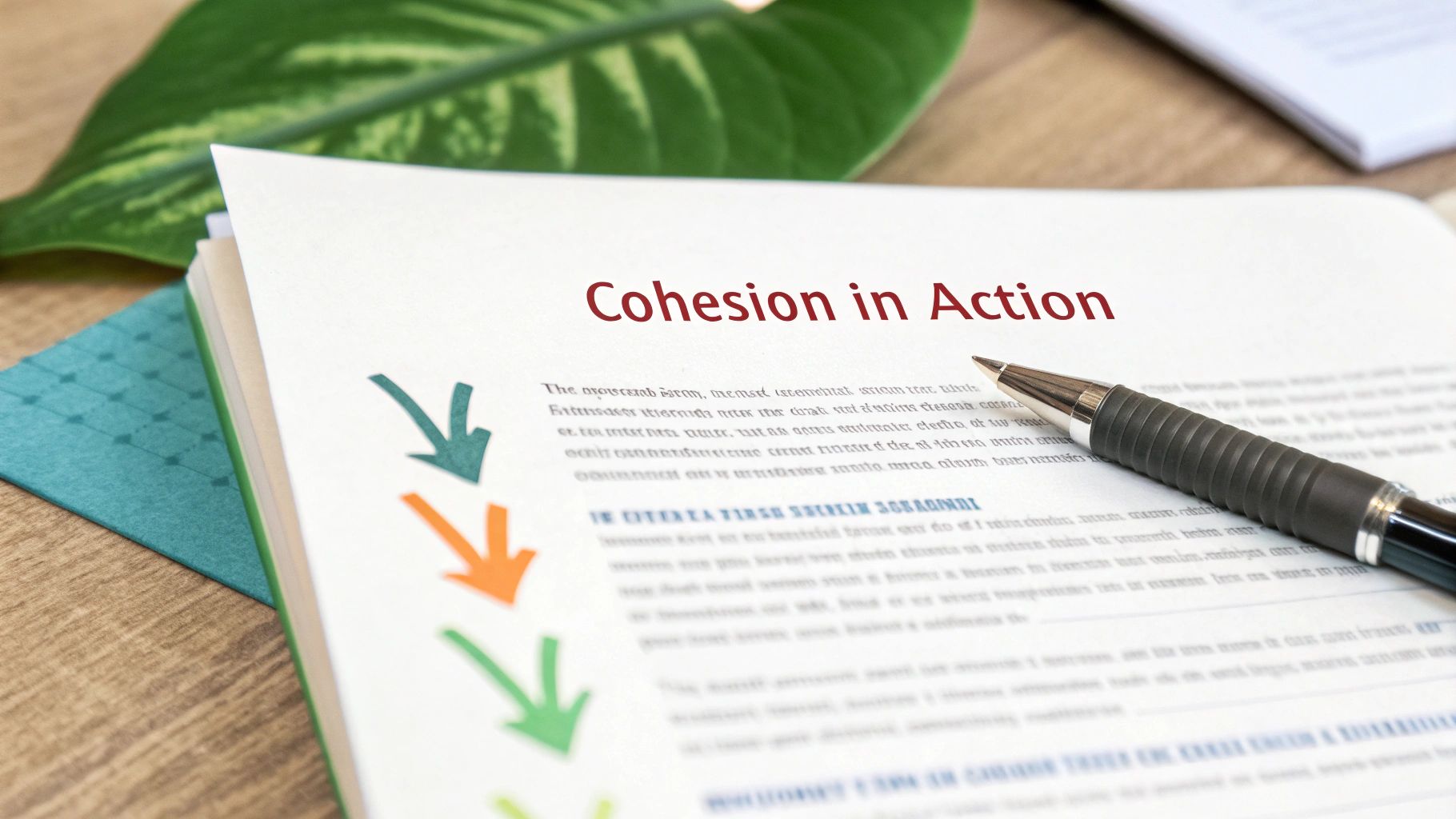
It’s one thing to know the names of cohesive devices, but it's another thing entirely to see them turn a clunky paragraph into something smooth and polished. The best way to really get a feel for what cohesion in writing means is to watch it happen.
Let's take a poorly written paragraph, break it down, and then build it back up, pointing out the exact changes that make it click. This hands-on look will show you how a few simple tweaks can make your message clearer, stronger, and far more professional.
Example 1: The Disjointed Draft
First, let's look at a paragraph that’s missing the glue. The ideas are all there, but the connections are weak, forcing the reader to do all the work.
The marketing team launched a new campaign. The marketing team hoped the new campaign would increase sales. Social media was the primary channel for the campaign. The campaign included video ads and influencer posts. The results were tracked using analytics software. The results showed a moderate increase in engagement.
You can feel the choppy, stop-and-start rhythm. Phrases like "the marketing team" and "the campaign" get repeated over and over, and there are no transition words to guide us from one thought to the next. Now, let’s fix it.
Example 2: The Cohesive Revision
Here’s that same paragraph, but this time rewritten with cohesive devices to create a natural, logical flow. I’ve annotated the specific changes so you can see exactly how they work.
The marketing team launched a new campaign, which they hoped would increase sales. Primarily, it ran on social media and included both video ads and influencer posts. Afterward, the team tracked the results using analytics software. This data revealed a moderate increase in engagement.
Annotation Breakdown:
- which: This little pronoun connects the campaign to the team's goal, merging two short sentences into one fluid thought.
- Primarily: An adverb that acts as a signpost, telling the reader we're about to get the most important detail about the campaign's channels.
- it: A simple pronoun that stands in for "the campaign," instantly cutting out the repetition.
- and: A basic conjunction that seamlessly links the two types of content (video ads and influencer posts).
- Afterward: This transitional word creates a clear timeline, showing what happened after the launch.
- This data: A great example of lexical cohesion. "This" points directly to the previous sentence, while "data" is used as a synonym for "results," avoiding yet another repeat.
This revised version isn't just easier to read—it feels more sophisticated. It proves how a few well-placed words can turn a disconnected list of facts into a real story. And these small changes are what keep a reader locked in.
In fact, this isn't just a matter of style. A 2022 study found that student essays with strong cohesion scored an average of 25% higher on comprehension tests. If you want to dive deeper, you can learn how cohesion impacts understanding on eapfoundation.com.
The key is making sure each sentence logically builds on the one before it, often anchored by a strong topic sentence. For more on that, check out our guide on how to write effective topic sentences for body paragraphs.
Spotting and Fixing Common Cohesion Mistakes
Even the sharpest writers stumble into cohesion traps. The real skill isn't just writing a clean first draft—it's knowing how to spot and fix the subtle disconnects that can trip up a reader. Think of this as your field guide for strengthening the invisible threads that hold your writing together.
Learning what cohesion in writing truly means is about becoming your own best editor. The goal is to train your eye to catch the little hitches that break the reader's journey. Once you recognize these common patterns, you can make sure your message lands with clarity, logic, and impact.
Ambiguous Pronoun References
One of the most common culprits is the ambiguous pronoun. This is when you use a word like "it," "he," "she," or "they," and it's not 100% clear who or what you're talking about. This tiny bit of confusion forces the reader to pause, reread, and figure it out, which completely shatters the flow.
Error Example: The manager told the employee he would receive a bonus.
- So, who gets the bonus? The manager or the employee? The pronoun "he" could point to either person, leaving the meaning up in the air.
How to Fix It: When in doubt, spell it out. A simple rephrase is often all you need to restore clarity.
- Revision: The manager told the employee that the employee would receive a bonus. Or, if the manager is the one getting it: The manager, who was receiving a bonus, shared the news with the employee.
Overusing Transition Words
Transition words like "however," "therefore," and "additionally" are fantastic tools, but overdoing it can make your writing feel clunky and robotic. When every other sentence starts with a signpost, the natural rhythm gets lost. It's like a tour guide shouting, "And now, we are walking into the next room!" at every single doorway.
The best cohesion is invisible. The connections feel so natural that the reader doesn't even notice the mechanics behind them. You're aiming for a seamless experience, not a connect-the-dots exercise.
Often, if your ideas are arranged in a logical sequence, the connection is already there. Trust your reader to follow along without needing a constant verbal nudge.
Weak Lexical Chains
Another subtle but sneaky mistake is creating a weak or broken lexical chain. This happens when you fail to consistently use synonyms or related terms to keep a core idea front and center. The topic seems to flicker in and out of focus, making your argument feel disjointed.
Error Example: Digital marketing is a critical skill for modern businesses. Companies need a strong online presence. Social media is one important channel for this.
- These ideas are related, sure, but the sentences jump between "digital marketing," "online presence," and "social media" without a clear thread connecting them.
How to Fix It: Weave in related words and concepts to keep reinforcing your main point.
- Revision: Digital marketing is a critical skill for modern businesses. A key part of this strategy is building a strong online presence, and social media is one important channel for achieving that goal.
Quick-Fix Guide for Common Cohesion Errors
Sometimes, all you need is a quick checklist to diagnose and fix issues in your draft. This table is designed to help you spot common cohesion problems and apply a simple solution.
| Common Error | Example of Error | How to Fix It |
|---|---|---|
| Ambiguous Pronoun | After Sarah talked to Maria, she felt much better. (Who felt better?) | Replace the pronoun with the specific noun: After Sarah talked to Maria, Maria felt much better. |
| Overused Transitions | First, we analyzed the data. Next, we created a report. Then, we presented the findings. | Remove unnecessary transitions and let the logical flow connect the ideas. We analyzed the data, created a report, and presented the findings. |
| Weak Lexical Chain | Good writing is important. You need to make sure your sentences are clear. Also, spelling matters. | Weave in related terms to reinforce the main topic: Good writing is important. You need to ensure your prose is clear and your spelling is flawless to produce quality text. |
| Inconsistent Verb Tense | He walks into the room and saw the mess. | Pick one tense and stick with it. He walked into the room and saw the mess. Or, He walks into the room and sees the mess. |
| Repeated Words | The report was a very important report because the report contained key data. | Use substitution or synonyms. The report was crucial because it contained key data. |
Think of this as a pre-flight check before you publish. Running your draft through these quick fixes can catch a surprising number of issues and dramatically improve readability.
Actionable Techniques to Improve Writing Flow
https://www.youtube.com/embed/hhVic18H4u4
Knowing the theory is one thing, but actually putting it to work is what separates good writing from great writing. To really strengthen your grasp of cohesion, you need to build some hands-on editing habits. These techniques will help you turn abstract concepts into a concrete part of your revision process, making your writing flow more naturally.
One of the most effective strategies is reverse outlining. After you've finished a draft, go back and jot down the main point of each paragraph. This gives you a bird's-eye view of your structure, making it incredibly easy to spot logical jumps, repetitive ideas, or paragraphs that just don't belong.
Another powerful trick? Reading your work aloud. Seriously, do it. Your ears will catch what your eyes might miss—awkward phrasing, clunky sentences, or abrupt transitions that kill the rhythm. If a sentence makes you stumble when you say it, it will definitely make your reader stumble when they read it.
Fine-Tuning Your Cohesive Toolkit
Beyond those foundational habits, you can try some targeted exercises to sharpen specific cohesion skills. These methods help you zoom in on the sentence-level connections that create that seamless reading experience everyone loves.
- Create a Keyword Map: Identify the core concepts of your piece and list the keywords and synonyms you're using for each. This helps you build strong lexical chains and reinforce your main themes without sounding like a broken record.
- Focus on Sentence Beginnings: Do a quick scan of your draft and just look at how each sentence starts. If too many begin the same way (e.g., "The company did X. The company did Y."), it’s a red flag. You need to vary your sentence structure for better flow. If you want to dive deeper, you can explore our guide on how to vary sentence structure.
Practicing these techniques doesn't just improve the final product. It makes you a more conscious and efficient writer, building the muscle memory you need for better first drafts.
In fact, some data shows that writers who master cohesive techniques reduce their rewriting time by nearly 22% because their work requires far less editing for flow and clarity. For a complete guide on crafting strategic content that connects with an audience—which relies heavily on strong cohesion—check out this resource on mastering general content writing.
Feeling good about your flow but worried your draft still sounds a little robotic? Natural Write is the perfect final check. Our platform instantly refines AI-generated text into natural, human-like prose that sails past AI detectors. Polish your writing and make sure it reads like you at https://naturalwrite.com.

